Partha Talukdar
University of Pennsylvania
SMOL: Professionally translated parallel data for 115 under-represented languages
Feb 17, 2025Abstract:We open-source SMOL (Set of Maximal Overall Leverage), a suite of training data to unlock translation for low-resource languages (LRLs). SMOL has been translated into 115 under-resourced languages, including many for which there exist no previous public resources, for a total of 6.1M translated tokens. SMOL comprises two sub-datasets, each carefully chosen for maximum impact given its size: SMOL-Sent, a set of sentences chosen for broad unique token coverage, and SMOL-Doc, a document-level source focusing on a broad topic coverage. They join the already released GATITOS for a trifecta of paragraph, sentence, and token-level content. We demonstrate that using SMOL to prompt or fine-tune Large Language Models yields robust ChrF improvements. In addition to translation, we provide factuality ratings and rationales for all documents in SMOL-Doc, yielding the first factuality datasets for most of these languages.
IndicGenBench: A Multilingual Benchmark to Evaluate Generation Capabilities of LLMs on Indic Languages
Apr 25, 2024Abstract:As large language models (LLMs) see increasing adoption across the globe, it is imperative for LLMs to be representative of the linguistic diversity of the world. India is a linguistically diverse country of 1.4 Billion people. To facilitate research on multilingual LLM evaluation, we release IndicGenBench - the largest benchmark for evaluating LLMs on user-facing generation tasks across a diverse set 29 of Indic languages covering 13 scripts and 4 language families. IndicGenBench is composed of diverse generation tasks like cross-lingual summarization, machine translation, and cross-lingual question answering. IndicGenBench extends existing benchmarks to many Indic languages through human curation providing multi-way parallel evaluation data for many under-represented Indic languages for the first time. We evaluate a wide range of proprietary and open-source LLMs including GPT-3.5, GPT-4, PaLM-2, mT5, Gemma, BLOOM and LLaMA on IndicGenBench in a variety of settings. The largest PaLM-2 models performs the best on most tasks, however, there is a significant performance gap in all languages compared to English showing that further research is needed for the development of more inclusive multilingual language models. IndicGenBench is released at www.github.com/google-research-datasets/indic-gen-bench
LLM Augmented LLMs: Expanding Capabilities through Composition
Jan 04, 2024



Abstract:Foundational models with billions of parameters which have been trained on large corpora of data have demonstrated non-trivial skills in a variety of domains. However, due to their monolithic structure, it is challenging and expensive to augment them or impart new skills. On the other hand, due to their adaptation abilities, several new instances of these models are being trained towards new domains and tasks. In this work, we study the problem of efficient and practical composition of existing foundation models with more specific models to enable newer capabilities. To this end, we propose CALM -- Composition to Augment Language Models -- which introduces cross-attention between models to compose their representations and enable new capabilities. Salient features of CALM are: (i) Scales up LLMs on new tasks by 're-using' existing LLMs along with a few additional parameters and data, (ii) Existing model weights are kept intact, and hence preserves existing capabilities, and (iii) Applies to diverse domains and settings. We illustrate that augmenting PaLM2-S with a smaller model trained on low-resource languages results in an absolute improvement of up to 13\% on tasks like translation into English and arithmetic reasoning for low-resource languages. Similarly, when PaLM2-S is augmented with a code-specific model, we see a relative improvement of 40\% over the base model for code generation and explanation tasks -- on-par with fully fine-tuned counterparts.
Self-Influence Guided Data Reweighting for Language Model Pre-training
Nov 02, 2023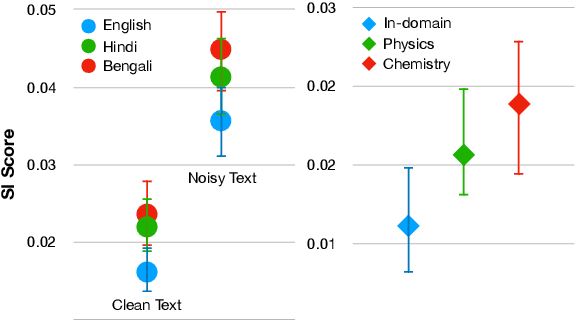
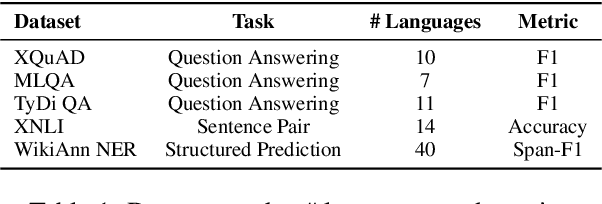
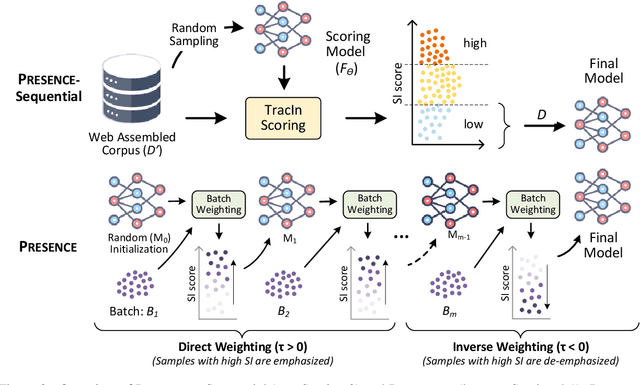
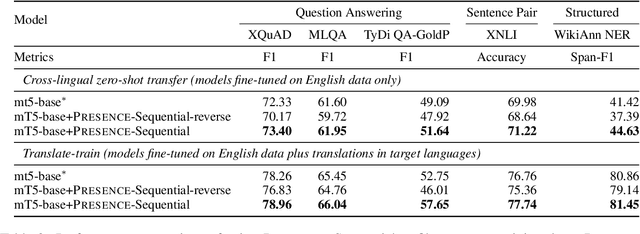
Abstract:Language Models (LMs) pre-trained with self-supervision on large text corpora have become the default starting point for developing models for various NLP tasks. Once the pre-training corpus has been assembled, all data samples in the corpus are treated with equal importance during LM pre-training. However, due to varying levels of relevance and quality of data, equal importance to all the data samples may not be the optimal choice. While data reweighting has been explored in the context of task-specific supervised learning and LM fine-tuning, model-driven reweighting for pre-training data has not been explored. We fill this important gap and propose PRESENCE, a method for jointly reweighting samples by leveraging self-influence (SI) scores as an indicator of sample importance and pre-training. PRESENCE promotes novelty and stability for model pre-training. Through extensive analysis spanning multiple model sizes, datasets, and tasks, we present PRESENCE as an important first step in the research direction of sample reweighting for pre-training language models.
Multimodal Modeling For Spoken Language Identification
Sep 19, 2023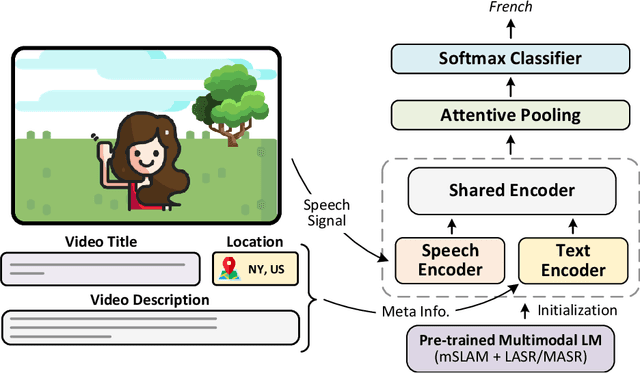

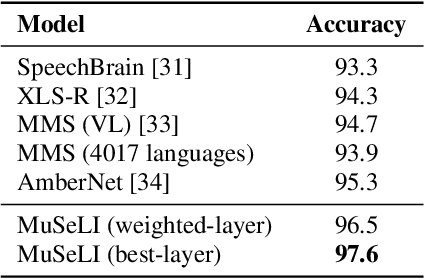
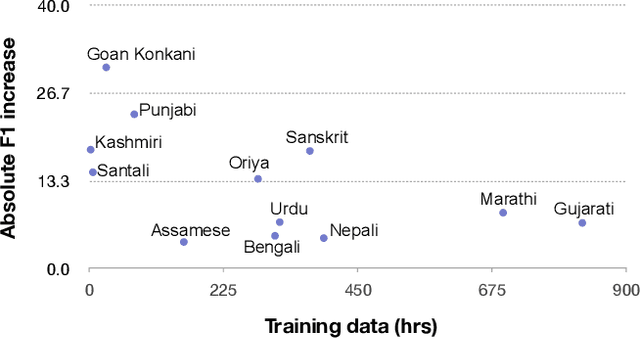
Abstract:Spoken language identification refers to the task of automatically predicting the spoken language in a given utterance. Conventionally, it is modeled as a speech-based language identification task. Prior techniques have been constrained to a single modality; however in the case of video data there is a wealth of other metadata that may be beneficial for this task. In this work, we propose MuSeLI, a Multimodal Spoken Language Identification method, which delves into the use of various metadata sources to enhance language identification. Our study reveals that metadata such as video title, description and geographic location provide substantial information to identify the spoken language of the multimedia recording. We conduct experiments using two diverse public datasets of YouTube videos, and obtain state-of-the-art results on the language identification task. We additionally conduct an ablation study that describes the distinct contribution of each modality for language recognition.
Label Aware Speech Representation Learning For Language Identification
Jun 07, 2023

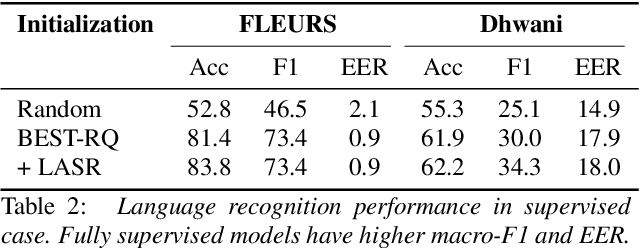

Abstract:Speech representation learning approaches for non-semantic tasks such as language recognition have either explored supervised embedding extraction methods using a classifier model or self-supervised representation learning approaches using raw data. In this paper, we propose a novel framework of combining self-supervised representation learning with the language label information for the pre-training task. This framework, termed as Label Aware Speech Representation (LASR) learning, uses a triplet based objective function to incorporate language labels along with the self-supervised loss function. The speech representations are further fine-tuned for the downstream task. The language recognition experiments are performed on two public datasets - FLEURS and Dhwani. In these experiments, we illustrate that the proposed LASR framework improves over the state-of-the-art systems on language identification. We also report an analysis of the robustness of LASR approach to noisy/missing labels as well as its application to multi-lingual speech recognition tasks.
XTREME-UP: A User-Centric Scarce-Data Benchmark for Under-Represented Languages
May 24, 2023



Abstract:Data scarcity is a crucial issue for the development of highly multilingual NLP systems. Yet for many under-represented languages (ULs) -- languages for which NLP re-search is particularly far behind in meeting user needs -- it is feasible to annotate small amounts of data. Motivated by this, we propose XTREME-UP, a benchmark defined by: its focus on the scarce-data scenario rather than zero-shot; its focus on user-centric tasks -- tasks with broad adoption by speakers of high-resource languages; and its focus on under-represented languages where this scarce-data scenario tends to be most realistic. XTREME-UP evaluates the capabilities of language models across 88 under-represented languages over 9 key user-centric technologies including ASR, OCR, MT, and information access tasks that are of general utility. We create new datasets for OCR, autocomplete, semantic parsing, and transliteration, and build on and refine existing datasets for other tasks. XTREME-UP provides methodology for evaluating many modeling scenarios including text-only, multi-modal (vision, audio, and text),supervised parameter tuning, and in-context learning. We evaluate commonly used models on the benchmark. We release all code and scripts to train and evaluate models
Salient Span Masking for Temporal Understanding
Mar 22, 2023



Abstract:Salient Span Masking (SSM) has shown itself to be an effective strategy to improve closed-book question answering performance. SSM extends general masked language model pretraining by creating additional unsupervised training sentences that mask a single entity or date span, thus oversampling factual information. Despite the success of this paradigm, the span types and sampling strategies are relatively arbitrary and not widely studied for other tasks. Thus, we investigate SSM from the perspective of temporal tasks, where learning a good representation of various temporal expressions is important. To that end, we introduce Temporal Span Masking (TSM) intermediate training. First, we find that SSM alone improves the downstream performance on three temporal tasks by an avg. +5.8 points. Further, we are able to achieve additional improvements (avg. +0.29 points) by adding the TSM task. These comprise the new best reported results on the targeted tasks. Our analysis suggests that the effectiveness of SSM stems from the sentences chosen in the training data rather than the mask choice: sentences with entities frequently also contain temporal expressions. Nonetheless, the additional targeted spans of TSM can still improve performance, especially in a zero-shot context.
Cultural Re-contextualization of Fairness Research in Language Technologies in India
Nov 21, 2022Abstract:Recent research has revealed undesirable biases in NLP data and models. However, these efforts largely focus on social disparities in the West, and are not directly portable to other geo-cultural contexts. In this position paper, we outline a holistic research agenda to re-contextualize NLP fairness research for the Indian context, accounting for Indian societal context, bridging technological gaps in capability and resources, and adapting to Indian cultural values. We also summarize findings from an empirical study on various social biases along different axes of disparities relevant to India, demonstrating their prevalence in corpora and models.
UGIF: UI Grounded Instruction Following
Nov 14, 2022



Abstract:New smartphone users have difficulty engaging with it and often use only a limited set of features like calling and messaging. These users are hesitant to explore using the smartphone and rely on experienced users to teach them how to use the phone. However, experienced users are not always around to guide them. To help new users learn how to use the phone on their own, we propose a natural language based instruction following agent that operates over the UI and shows the user how to perform various tasks. Common how-to questions, such as "How to block calls from unknown numbers?", are documented on support sites with a sequence of steps in natural language describing what the user should do. We parse these steps using Large Language Models (LLMs) and generate macros that can be executed on-device when the user asks a query. To evaluate this agent, we introduce UGIF-DataSet, a multi-lingual, multi-modal UI grounded dataset for step-by-step task completion on the smartphone. It contains 523 natural language instructions with paired sequences of multilingual UI screens and actions that show how to execute the task in eight languages. We compare the performance of different large language models including PaLM, GPT3, etc. and find that the end-to-end task completion success rate is 48% for English UI but the performance drops to 32% for non-English languages. We analyse the common failure modes of existing models on this task and point out areas for improvement.
 Add to Chrome
Add to Chrome Add to Firefox
Add to Firefox Add to Edge
Add to Edge